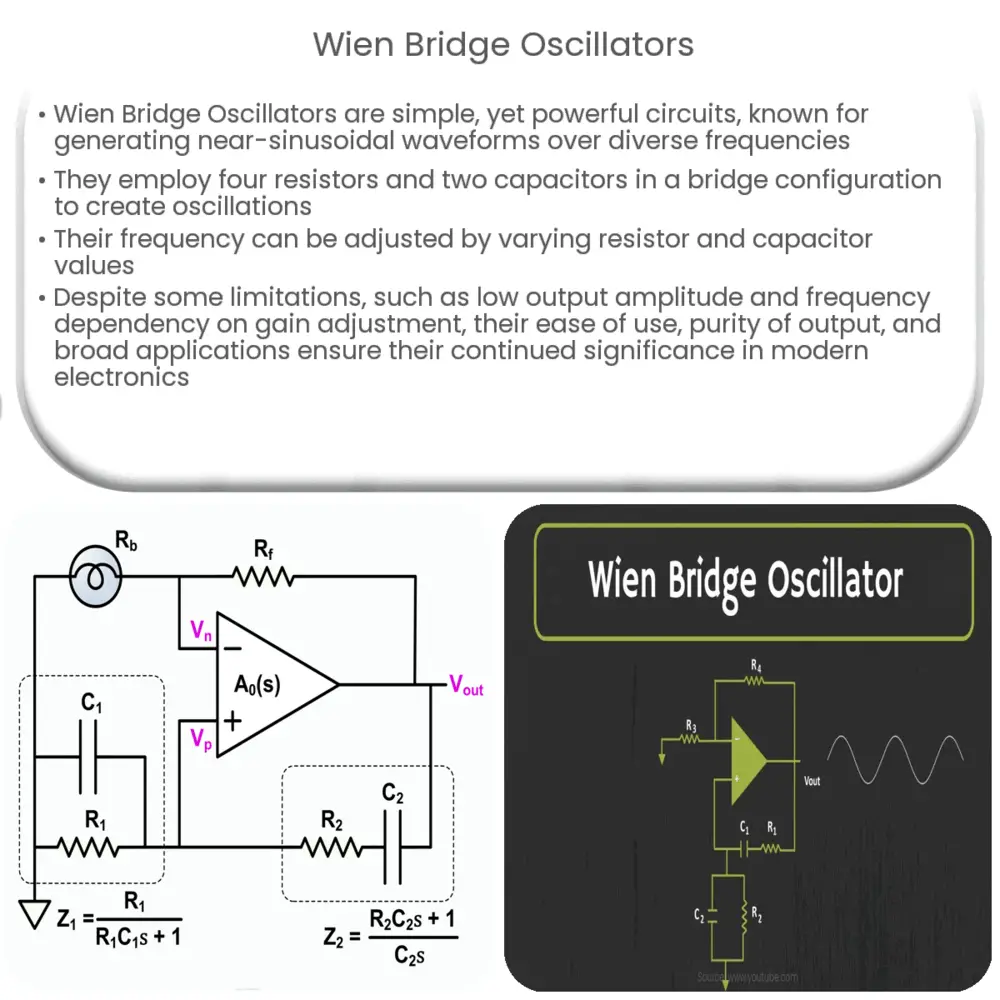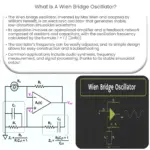Dive into the workings of Wien Bridge Oscillators, their components, applications, and their influential role in modern electronics.

Introduction to Wien Bridge Oscillators
Wien Bridge Oscillators are a type of electronic oscillator circuit which generates sinusoidal outputs. Named after Max Wien, who originally proposed the bridge configuration in 1891, it wasn’t until 1940 that William Hewlett adapted it to design an oscillator circuit as part of his educational studies. This very design laid the foundation for the birth of Hewlett-Packard, a name now synonymous with the technology industry.
Working Principle
The operation of a Wien Bridge Oscillator hinges on the concept of a bridge circuit and the principles of feedback in electronic circuits. In its most basic form, the oscillator contains four resistors and two capacitors in a bridge configuration. This setup ensures that the phase shift around the loop is zero degrees, which is the prerequisite for sustained oscillation in any feedback circuit. In effect, the Wien Bridge Oscillator acts as a frequency selective feedback circuit that responds maximally at a certain frequency, known as the resonant frequency.
Components of a Wien Bridge Oscillator
- R1, R2: These are two resistors of the same value. They constitute one of the arms of the Wien Bridge.
- C1, C2: These are two capacitors of the same value, forming the second arm of the bridge.
- Amplifier: This is a vital part of the circuit, amplifying the signal before feeding it back into the circuit. The amplifier also maintains the amplitude of the oscillations.
Applications of Wien Bridge Oscillators
Wien Bridge Oscillators serve a wide array of applications in the electronic world. These include audio and radio frequency generations, function generators in laboratories, and signal processing in communication devices. Their simple circuitry, ease of frequency tunability, and capability of generating pure sine waves make them the choice for various electronic applications.
Advantages and Disadvantages
The primary advantage of a Wien Bridge Oscillator is its ability to generate nearly sinusoidal waves over a wide range of frequencies, which is a rarity among oscillator circuits. It also has good frequency stability and a very simple design structure. However, these oscillators do suffer from a few disadvantages, such as low output amplitude, dependency on gain adjustment for oscillation frequency, and the inability to produce high frequencies.
Calculating the Frequency of Oscillation
The frequency of oscillation in a Wien Bridge Oscillator is governed by the values of the resistors and capacitors. The formula for calculating this is given as f = 1 / (2πRC), where R is the resistance and C is the capacitance.
Implementation of a Wien Bridge Oscillator
In a practical Wien Bridge Oscillator circuit, a non-inverting operational amplifier (op-amp) is typically used. The positive input to the op-amp is the junction point of the series RC, while the negative input is the junction point of the parallel RC. The output of the amplifier is fed back to both its inputs through the RC network, thus forming a positive feedback loop. One key detail in this design is the inclusion of an automatic gain control circuit (AGC), which helps to stabilize the output amplitude.
Adjusting the Frequency
The frequency of the Wien Bridge Oscillator can be adjusted by varying the values of the resistors and capacitors in the RC network. In practice, a variable resistor or a variable capacitor is often used for this purpose. By adjusting this component, the user can tune the oscillator to the desired frequency.
Advanced Applications
Wien Bridge Oscillators have found their place in advanced applications, too. In the field of audio synthesis, for instance, they are used for their ability to produce low distortion sine waves over a wide range of frequencies. In telecommunications, they are often employed in signal generators to test the frequency response of various electronic devices.
The Role in Modern Electronics
Although Wien Bridge Oscillators may seem rudimentary compared to today’s high-tech digital circuits, they remain integral to understanding the core concepts of electronic oscillation and wave generation. Modern frequency generators and digital synthesizers still base their fundamental working principles on the same concepts embodied by the Wien Bridge Oscillator.
Conclusion
In summary, the Wien Bridge Oscillator is a simple yet powerful electronic circuit, capable of generating nearly sinusoidal waveforms over a broad range of frequencies. Its simple design, ease of tunability, and the purity of its output have made it a staple in electronic engineering and various related fields. Despite its few disadvantages, its influence in modern electronics is irrefutable, marking its significance not just historically but also in contemporary applications. Understanding its design and operation provides a foundation for the study and development of complex wave-generating circuits in today’s digital world.



